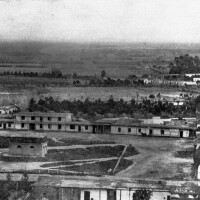What's Missing From the Earliest-Known Drawing of Los Angeles?

Without the handwritten caption reading "Part of Los Angeles," it might be difficult to place the above drawing – generally considered to be the oldest extant drawing of the city. The Los Angeles that William Rich Hutton saw when he first arrived on July 7, 1847, is virtually unrecognizable today.
Hutton came to Los Angeles as a clerk to his uncle and eponym William Rich, a paymaster in the United States Army. Together they had sailed to the rudimentary harbor at San Pedro on the USS Lexington. When they landed, their cargo – pay for the U.S. troops occupying the Mexican city – required an escort of eleven armed cavalrymen.
Because the hill also represented the seat of American power in the occupied city, his view approximated that of the invading forces – and their cannon.
The horseback ride from San Pedro to the ciudad took eight hours. Hutton recorded in his diary: "Saw a large grey wolf near the sheep farms."
They remained in Los Angeles for three weeks – long enough for Hutton to make three sketches of Los Angeles during his free time.
When he made the pencil drawing shown above, Hutton stood atop Fort Hill. Rising steeply behind the Plaza Church, the knoll was a natural vantage point. But because the hill also represented the seat of American power in the occupied city, his view approximated that of the invading forces – and their cannon.

Mexican-Californian forces had surrendered to John C. Fremont only months before. Far to the south, U.S. troops were advancing on Mexico City and, with the Treaty of Guadalupe-Hidalgo twenty months away, Los Angeles was still legally Mexican territory. The Americans treated it as an occupied city. Behind Hutton on the hill's strategic high ground, soldiers would have been hastily constructing a citadel with room for two hundred troops and embrasures for six cannon.
Early Representations of L.A.
Viewing the city from the site of these fortifications, Hutton's pencil traced the lines of the Plaza Church and nearby adobe houses. The plaza itself appears here as a vacant rectangular lot. A range of hills in the distance frames the scene, and a line of trees stretching horizontally across the entire drawing may trace the course of the Los Angeles River.
Notably absent are the city's inhabitants. At least one thousand people – many of them who may have objected to the Americans' presence – called Los Angeles home in 1847. Hutton's pencil sketched structures to be occupied and natural resources to be exploited, but why the existing community of people failed to make an impression remains an open question.
Hutton returned to Los Angeles several more times. In 1849 he assisted E. O. C. Ord with the city's first official survey and, over the course of his visits, produced several more drawings. An 1848 watercolor and pencil drawing provided evidence for animal (if not human) life in the city: a horse.
By the time he left California in 1853, Hutton had created at least 95 sketches. Along with his diaries and letters, these drawings remained prized possessions of his family until 1939, when the Huntington Library acquired them from his surviving daughters.
The version above – likely reproduced from the Huntington's copy – comes from the Title Insurance and Trust, and C.C. Pierce Photography Collection, on long-term loan from the California Historical Society to the USC Libraries. The Los Angeles Public Library's Photo Collection contains a reproduction another of Hutton's 1847 sketches (below), which looks at the city in a more southwesterly direction.





